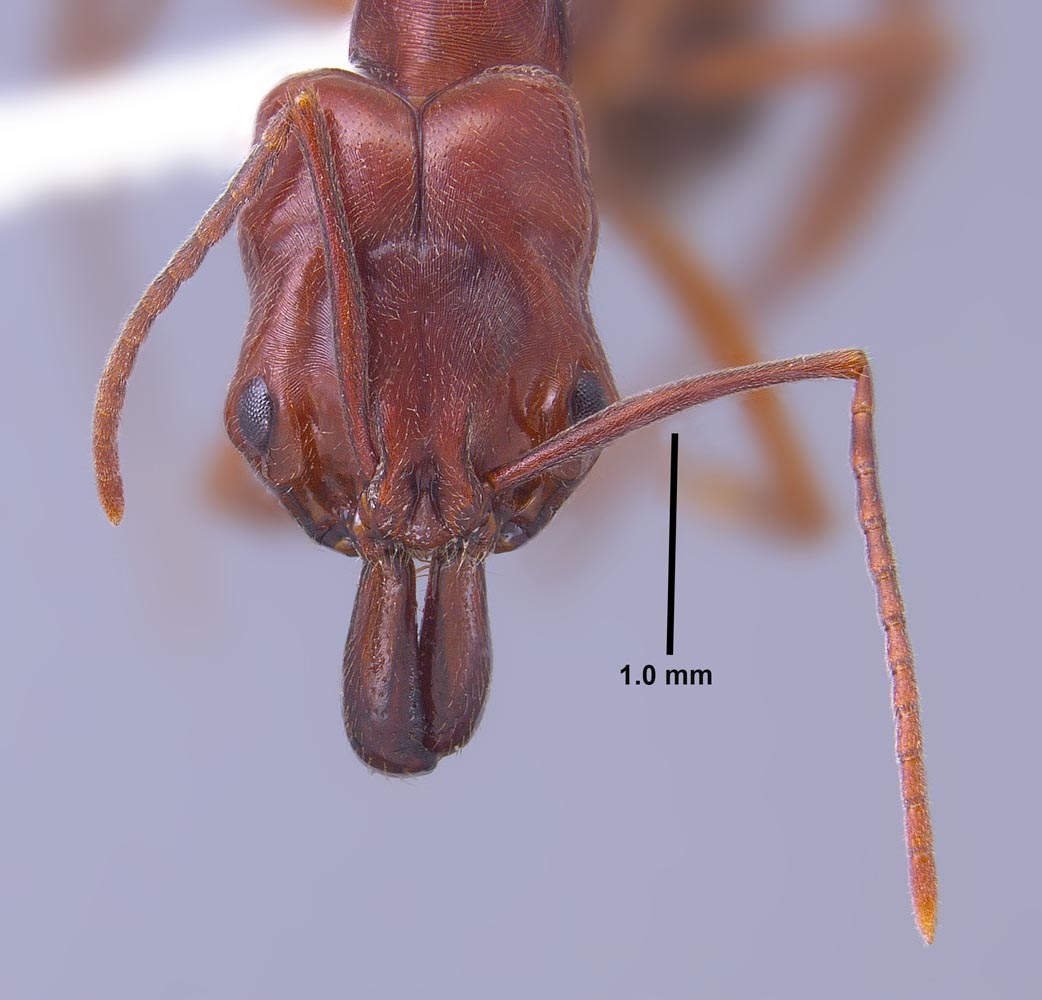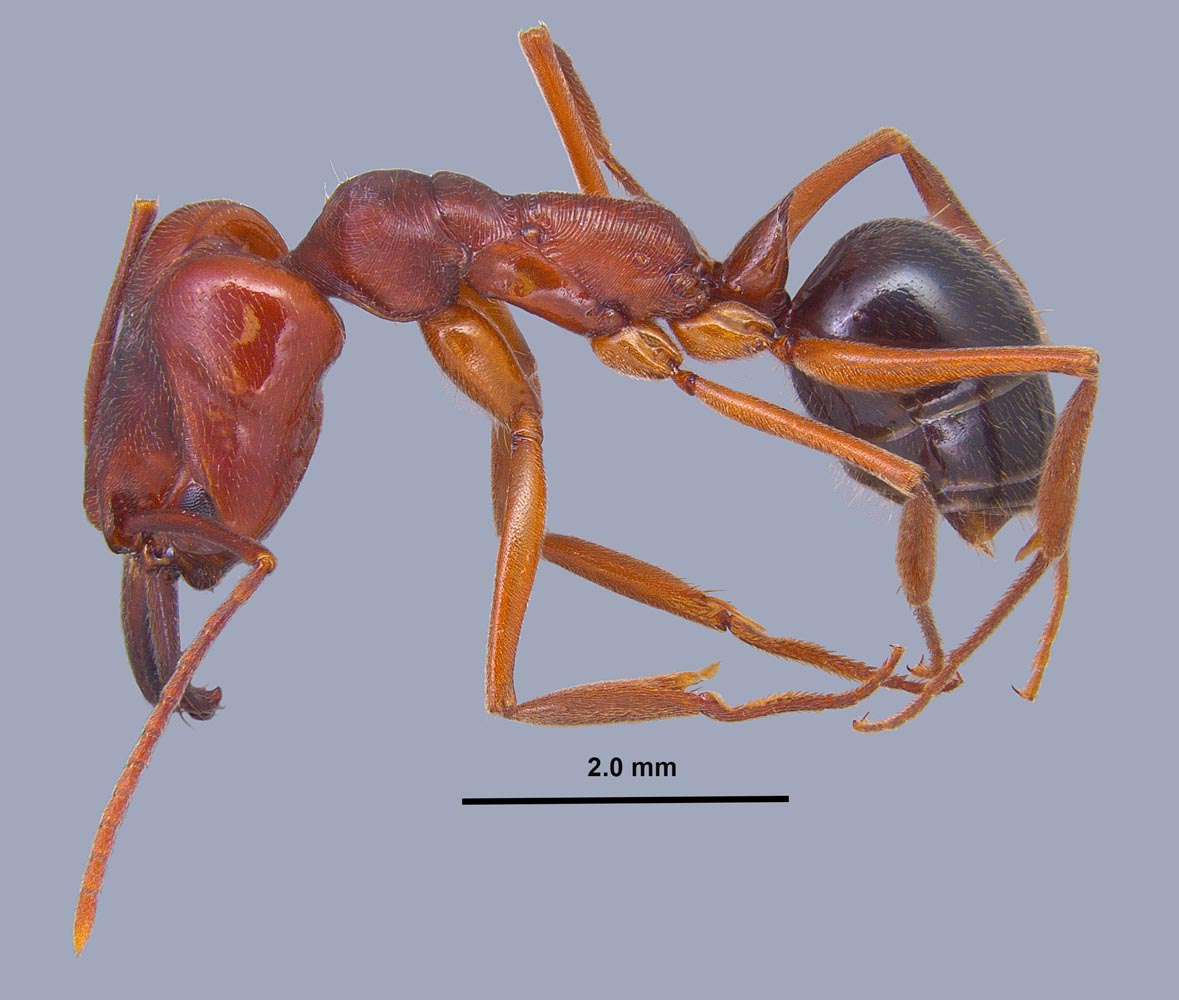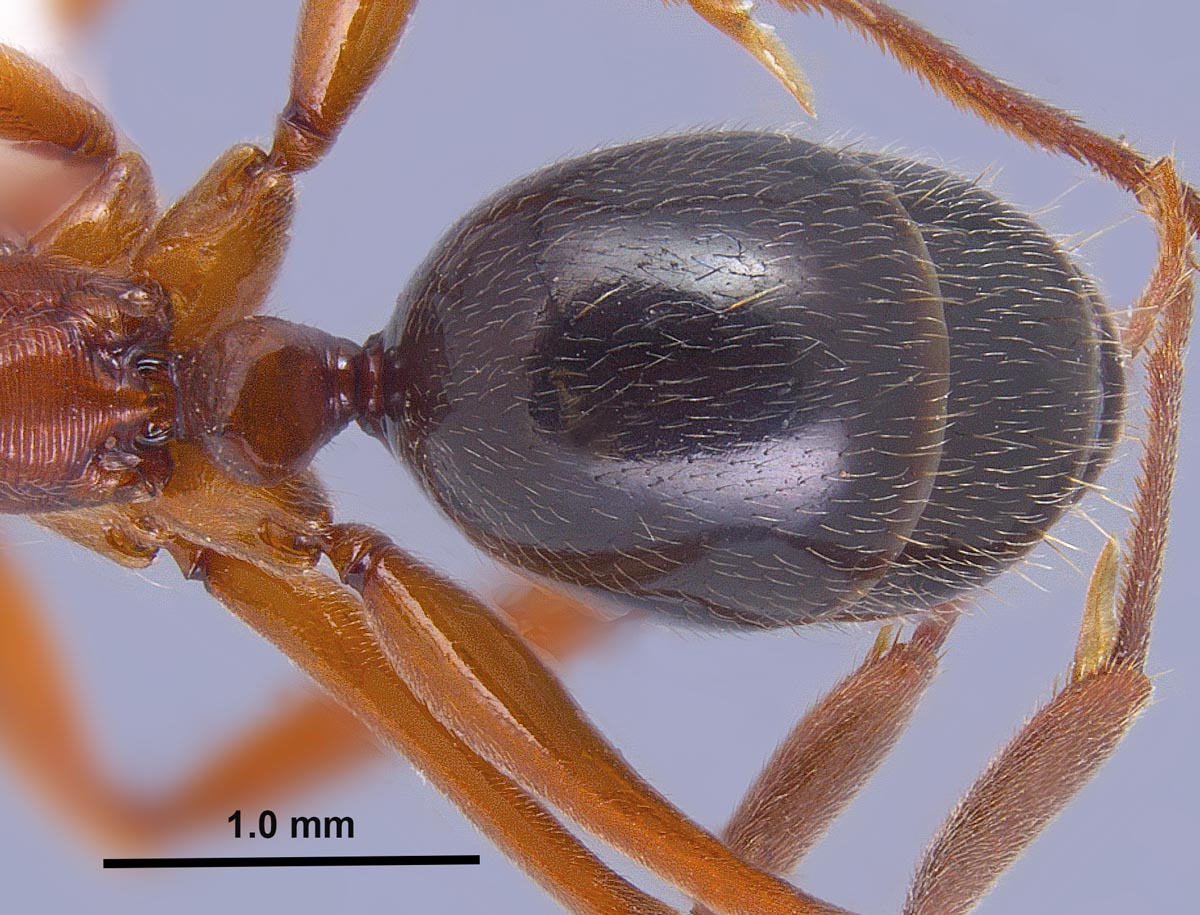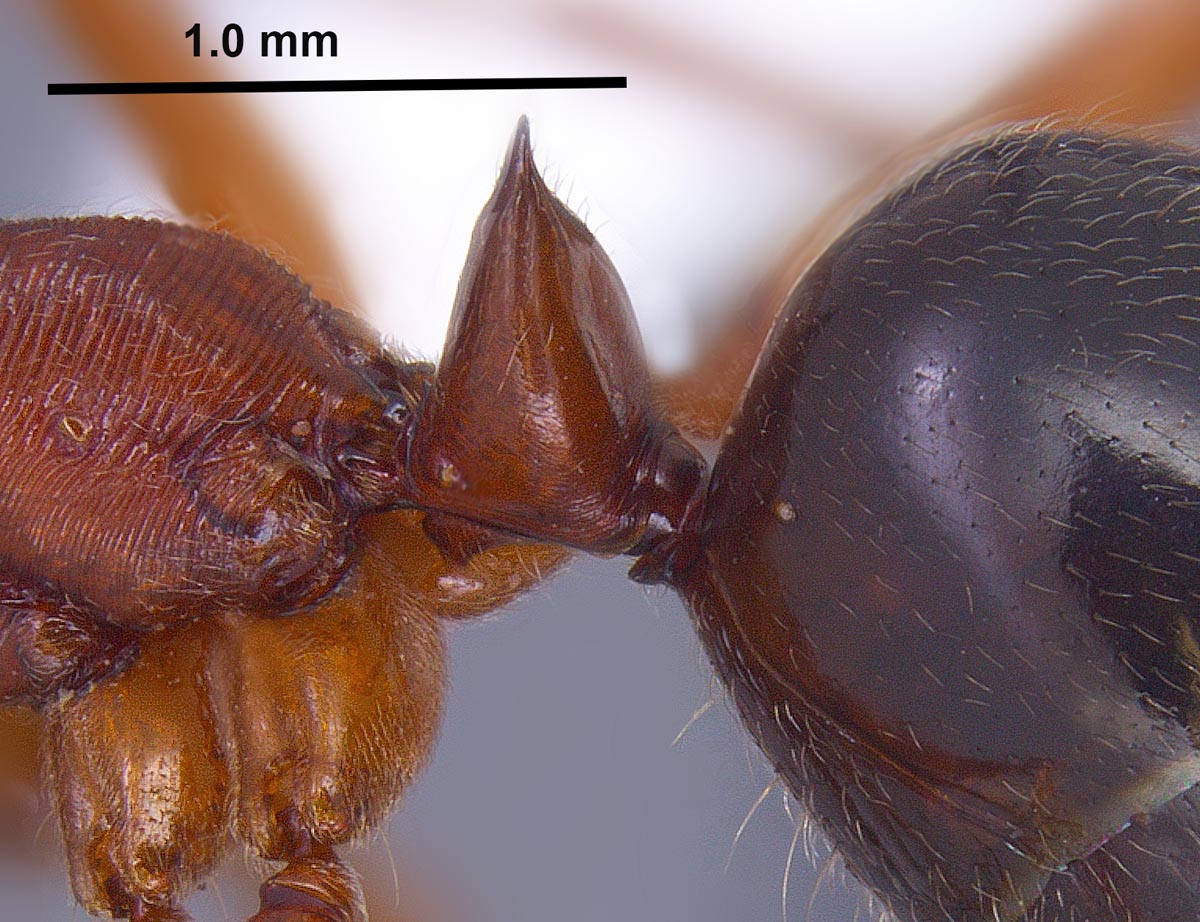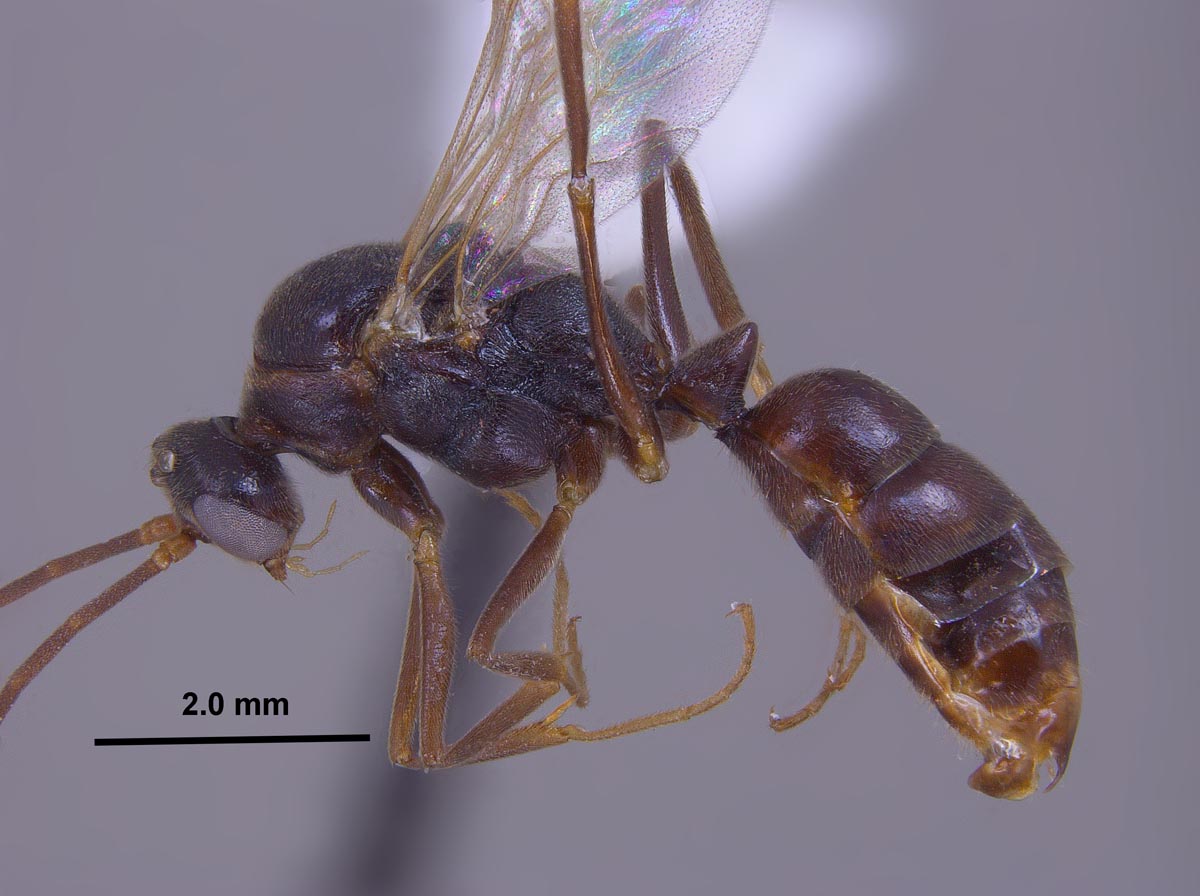Introduction
Ants in this genus differ from other ponerine ants found in the United States by the unique head shape; peculiar mandibles, which are elongate and inserted near the center of the clypeus; the large tapering petiole; and the large size of the workers (see photos above) (for a more detailed diagnosis of the genus, see MacGown et al. 2014). Members of this genus are commonly called trap-jaw ants due to their elongate mandibles, which can be opened to 180°, then snapped rapidly together on prey. These ants are amazing in their ability to control and time the mandibular movement. When necessary, an ant can forcibly close the mandibles against a surface or other organism and actually propel itself away for up to several inches! Remarkable behavior. Additionally, they can use the mandibles for much more sensitive movements such as caring for larvae or nest building.
Odontomachus clarus is typically considered to be a southwestern US species and was only recently discovered to occur in Louisiana (Adams et al. 2010). According to Deyrup and Cover (2004), this species nests under rocks or in grasses associated with arid and mesic habitats.
Taxonomic History (from Bolton, 2012)
Described as Odontomachus clarus by Roger (1861); treated as a subspecies of O. haematodus (Emery 1911); revived as a species by Taylor and Wilson (1962).
Identification
Worker: HL 1.92–2.32, HW 1.57–1.90, SL 1.68–1.90, EL 0.31–0.36, ML 1.06–1.30, WL 2.43–2.83, PTH 0.81–1.10, PTL 0.42–0.48 (n=7). Entire body generally shiny except where obscured by dense pubescence; head, mesosoma, and petiole reddish-brown, legs yellowish-brown to orangish-brown, and gaster blackish. Head with fine, longitudinal striae covering much of the head in full-face view, striae beginning from frontal lobes and diverging toward posterior corners of head, fading at corners and sides; sides and underside of head lacking sculpture; with numerous, fine, appressed pubescence and scattered elongate, erect setae present dorsally. Pronotum with circular, slightly concentric striae that become transverse near rear margin; appressed pubescence abundant; 5–6 elongate, erect setae present. Mesonotum and propodeum with deep transverse striae; propleuron, mesopleuron, and basalar lobe lacking sculpture; abundant pubescence present dorsally. Metasternum lacking paired elongate, spiniform processes between hind coxae. Petiole widest at base, either gradually tapering apically to a short spiniform spine or stoutly conical; mostly lacking striae with only faint striae present near base; subpetiolar process rounded triangular; appressed pubescence present anteriorly and laterally, but mostly absent posteriorly. Gaster mostly shiny beneath pubescence, lacking striae or other strong sculpture, but with fine coriaceous sculpture (seen at high magnification); slightly coarse, appressed pubescence somewhat sparse, hairs separated by at least ½ their length; scattered erect, elongate setae present.
Male: HL 0.91–0.97, HW 1.18–1.30, SL 0.17–0.25, EL 0.62–0.64, EW 0.35–0.37, OL 0.12–0.14, OES 0.25–0.26, PTH 0.66–0.73, WL 2.39–2.65, PTL 0.40–0.59, FWL 4.56–4.97 (n=3). Body generally shiny except where obscured by dense pubescence; head and mesosoma brownish-black, petiole and gaster dark reddish-brown to brownish-black, legs and antennae reddish-brown. Head and body with abundant semi erect, whitish pubescence. Eyes extremely large, maximum diameter of each eye at least 70% of the length of the head in full-face view. Ocelli small, the length of each ocellus about half the distance between lateral ocellus and eye margin; in full-face view, lateral ocelli do not noticeably protrude beyond posterior border of head. Mesosoma: pronotum lacking sculpture; mesoscutum with fine transversely arcuate striae anteriorly, striae becoming longitudinal posteriorly; mesoscutellum raised and convex, with longitudinal striae; propodeum and mesopleuron with weak to slightly strong longitudinal striae. Petiole bluntly rounded apically, with apically acute to apically rounded triangular subpetiolar process present anteriorly; densely pubescent anteriorly and laterally, with reduced pubescence posteriorly; petiolar sternum lacking angular process near posterior margin, but with paired setae on small tubercles.
Queen: No specimens measured, but similar to workers in color and general appearance except slightly larger, with mesosoma developed for wings.
Workers of O. clarus are most similar to O. relictus and O. desertorum, but are distinguished from O. relictus by their smooth basilar lobes (striate in O. relictus), and from O. desertorum by the following: Size smaller (HL < 2.2 mm, WL < 2.8 mm); dorsomedian petiolar process nub-like or well-differentiated; propleurae almost entirely smooth and polished-looking; pronotal cervical lobe longer than broad; and antennal scapes relatively shorter (SL/HW = 0.99–1.07 vs. 1.11–1.15). Odontomachus clarus is further differentiated from O. relictus by geography: O. clarus only occurs west of the Mississippi river; whereas, O. relictus only occurs east of the Mississippi river.Males are uniquely identifiable among the Nearctic fauna by, at minimum, the following combination of characters: 1) dark brown coloration; 2) ocelli small, weakly bulging past posterior head margin; 3) mesoscutum longitudinally striate (striae may be posterolaterally divergent); 4) posterior margin of petiolar sternum lacking an angular process, but with paired setae on tubercles; and 5) propodeum finely striate.
Biology and Economic Importance
Similar to other members of this subfamily, Odontomachus workers have a prominent sting(er), and have the ability to inflict a relatively painful sting.
Odontomachus clarus has been collected nesting under large rocks in sandy soil in the Kisatchie National Forest in Natchitoches Parish, Louisiana (Adams et al. 2010), in dry sites in Texas, and under rocks and grass tussocks in dry to mesic habitats in Arizono (Deyrup and Cover 2004).
Distribution (from MacGown et al. 2014)
Mexico. Chihuahua, Coahuila, Hidalgo, Nuevo Leon, and Clarion Island.
USA. Arizona: Cochise, Pima, Santa Cruz, and Yavapai Counties. New Mexico. McKinley County. Texas: Bastrop, Bexar, Bosque, Brewster, Brown, Denton, Jeff Davis, and Travis Counties. Louisiana: Natchitoches Parish.
Literature Cited
Adams, B. J., X. Chen, and L. M. Hooper-Bui. 2010. Odontomachus clarus Roger (Hymenoptera: Formicidae) Reported in Kisatchie National Forest, Louisiana. Midsouth Entomologist 3: 104-105. [Available online: http://midsouthentomologist.org.msstate.edu/pdfs/Vol3_2/Vol3_2_006.pdf]
Bolton, B. 2012. Bolton World Catalog Ants. accessed on October 2012. [Available online: http://www.antweb.org/world.jsp]
Deyrup, M. and S. Cover. 2004. A new species of Odontomachus ant (Hymenoptera: Formicidae) from inland ridges of Florida, with a key to Odontomachus of the United States. Florida Entomologist 87: 136-144.
Deyrup, M., J. Trager, and N. s 1985. The genus Odontomachus in the southeastern United States (Hymenoptera: Formicidae). Entomological News 96: 188-195.
Emery, C. 1911e. Hymenoptera. Fam. Formicidae. Subfam. Ponerinae. Genera Insectorum 118:1-125.
MacGown, J. A., B. Boudinot, M. Deyrup, and D. M. Sorger. 2014. A review of the Nearctic Odontomachus (Hymenoptera: Formicidae: Ponerinae) with a treatment of the males. Zootaxa 3802 (4):515–552.
Taylor, R. W. and Wilson, E. O. 1962 ("1961"). Ants from three remote oceanic islands. Psyche (Cambridge) 68:137-144.


